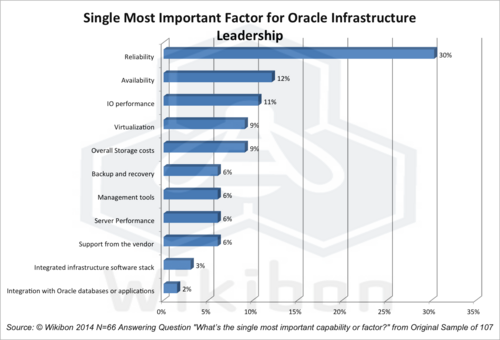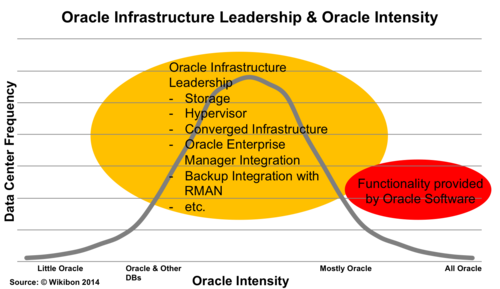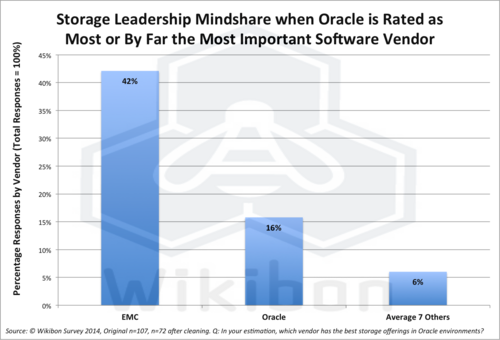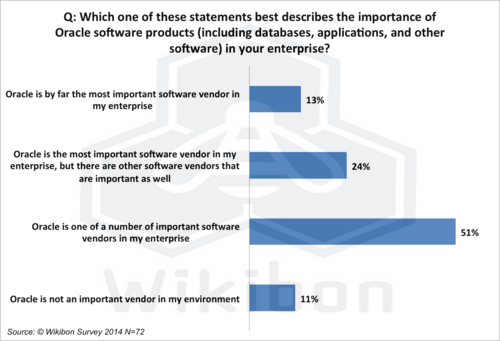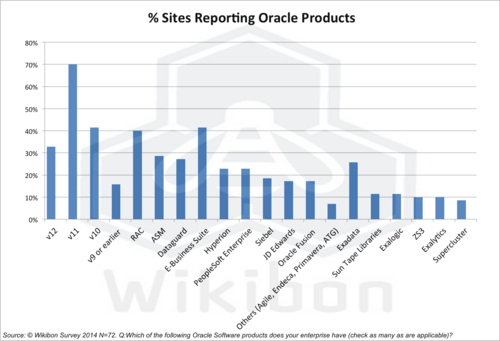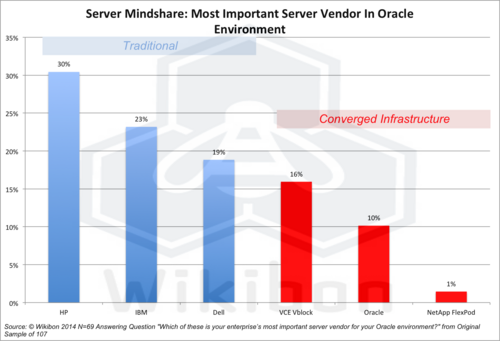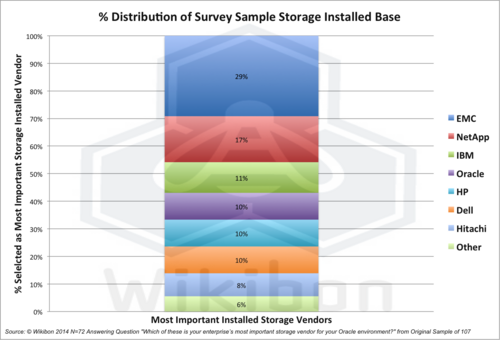Contents |
Executive Summary
Not surprisingly, our recent survey of the Oracle infrastructure practitioners in the Wikibon Community found that reliability and availability are the most important factors for Infrastructure in an Oracle environment. Forty-two percent of respondents (Figure 1 below) selected either reliability or availability when asked the question “What’s the single most important capability or factor" for their Oracle environment.
The full survey results in conjunction with other Wikibon research leads us to conclude that overall reliability for Oracle systems is a function of availability, recoverability & consistent performance. In Oracle environments, multiple servers and data paths provide insulation against most server and network outages. Storage functionality and design are the most important factors in Oracle availability.
In the Wikibon survey, storage was the next most important factor, with IO performance, overall storage costs and backup/recovery together representing 26% of the selections. Virtualization was also chosen by 9% as the single most important factor, a major change in attitude from just two years ago as VMware and other virtualization platforms have matured and Oracle has been forced to accept virtualized environments as best practice. Virtualization provides more choice and lower costs for "good-enough" high availability and allows better utilization of expensive server cores being used for database.
One of the surprising findings in the survey was the high placement of converged infrastructure in answer to a question about the most important server for the Oracle environment. Over one-quarter of the sample chose a converged infrastructure platform as their most important server, with VCE Vblock at 16%, Oracle at 10%, and NetApp Flexpod at 1% (see Figure 6 below for more details).
Figure 3 shows one of the most striking findings of the survey. In the paragraph above we emphasized the importance of storage infrastructure in Oracle environments. We also asked “In your estimation, which vendor has the best storage offerings in Oracle environments?” EMC was rated "best" with 42% with Oracle coming in second (16%). The remaining seven vendors averaged ~6% (Hitachi & HP had 11%, and the rest 5% or less). The designation of "best" for EMC and Oracle was much higher than their respective designation of the current "most important" Oracle storage environment vendor (29% for EMC and 10% for Oracle).
The conclusion of the study is that in most data centers where Oracle is the key or a key workload, best-of-breed open infrastructure has both business value and IT advantages over other infrastructure offerings. Some sites with extremely high availability requirements and high integration between Oracle database and business software may find the all-Oracle application-aware software approach preferable, given their specific business requirements. However, Wikibon believes that the “Fat Middle” of the “Oracle-intense” market (Figure 2 above) should obtain maximum value from a best-of-breed open infrastructure approach.
Wikibon found that EMC has the richest set of Oracle infrastructure functionality among the vendors. The Wikibon survey found that EMC has also by far the greatest mindshare, with 42% of the participants selecting EMC as having the best storage offerings in Oracle environments. Oracle has 16% of mindshare, and is ahead of the other storage vendors.
Infrastructure executives with responsibility for Oracle infrastructure environments should always look carefully at vendors with mindshare significantly greater than their marketshare! Wikibon would recommend that EMC be included for all RFPs for Oracle infrastructure environments. For very Oracle-intensive environments where Oracle software is being used for very high availability, EMC & Oracle should be included in the RFP.
Research Methodology
The research method was based on three major components:
- Deep-dive interviews relating to Oracle Storage Best Practices with:
- Well-established and recognized Oracle practitioners (including a number of DBAs) from the Wikibon community;
- Senior IT executives in Oracle-intense environments about the cost and business issues of different infrastructure strategies;
- Survey Results:
- Wikibon polled 108 members of our community using Oracle concerning their opinions of what “Leadership for Oracle Storage” meant to them and used that data to support and guide our conclusions;
- Within the survey we also asked our members about the infrastructure installed for their current Oracle environments and about how they rated vendors. We have used that information to establish mindshare for vendors in Oracle-intensive environments.
- Analysis – Wikibon analyzed all of our original data results in the context of extensive Wikibon research and knowledge in this area.
Observations about Leadership in Oracle Infrastructure
Wikibon interviewed people responsible for several heavy Oracle installations to discuss what is required for leadership in Oracle infrastructure.
- Oracle Mini Case Study 1 (Bank)
- IT has to deal continually with global expansion, mergers and the consolidation of business processes.
- Operationally complex implementations increase the importance of converged infrastructure. For example, an installation with a large number of users at launch, needing very fast response times and analytics and with multiple countries, almost mandates converged infrastructure as a major part of the infrastructure.
- The bank currently has separate storage, network, server and application teams.
- With converged infrastructure, how can the business be supported without having the DBA become the storage and network admin?
- A new team is in place that pulled in members from each discipline – with the DBA as the leader.
- Observations
- Banks are not a technology companies.
- Need to recognize that IT is not good at being a data center, storage or network company.
- If the requirement is too much for the infrastructure to support, outsource it.
- Reducing complexity is key.
- Oracle Mini Case Study 2 - (Very experienced DBA Consultant observations)
- The biggest issues are replication, cluster maintenance, backup and recovery management. Capacity planning and performance tuning are also important.
- Backup and recovery is very important and still eludes most DBAs. Backup should be thought of as the same as production and care taken to ensure it runs correctly.
- Oracle doesn’t have a good way to see the backup inventory. When a 100+ databases are backed up, there’s no way to monitor this every day. Third party apps take the control of this out of the DBA’s hands. SAN tools are the best at this, but there’s no good DBA-centric tool. RMAN back-ups are too simplistic nowadays. The requirement is for backup environment that can be run in production mode, with the DBA having a view of backup completions and the ability to remediate problems.
- Spending sufficient time working with application development is key. Developers are seen as fast moving, demanding and close to the business. Admins are technical guys who sit and watch the screens. DBAs sit in the middle and rely on both.
- Letting Oracle converged infrastructure run the entire stack from the grid infrastructure and cluster-ware in ASM makes system admins nervous. It's tough for them to “let go”.
- RAC is not all you need to guarantee high availability. Diagnostics, performance tuning, and maybe partitioning are needed.
- Capacity planning in complex Oracle systems is extremely difficult - there is no solid tool for CPU, RAM, server and clustering capacity planning. These problems tend to be addressed in an emergency.
- A thorough analysis of system bottlenecks and how they are affecting the business, so business performance can be measured, is vital. Traditional sys admin tools are not sufficient and are very hard pressed to give solid metrics.
- The best tool would provide full stack visibility with a dashboard.
- Oracle Enterprise Manager is the best tool for identifying bottlenecks and seeing the full stack.
- EMC or Hitachi plug-ins into VMware give useful extra metrics. Blue Medora is a good plug-in for this.
- Good tools such as AWR (workload repository) and ASH allow for root cause analysis on most Oracle-related problems. The easy part is identifying the root cause. The hard part is getting someone to own up to it and fix it. The solution is usually to convene all the actors together to brainstorm and try to get consensus on action.
- Observations:
- Get the ridiculous minutia out of the way – get the tools to automate these things. Database creation, cloning, back-ups and recovery should all be automated.
- A tool or write the scripts necessary to monitor what’s going on with a dashboard is a worthwhile investment. Build up your script and tool library.
- Don’t throw hardware at a problem indiscriminately. Make sure that hardware is your problem before throwing more hardware at it.
- Mini Case Study 3 (Oracle DBA for 20 years in Defense and Finance)
- Most time is spend on availability and capacity planning because that’s the production environment. I want to be in a position where I can see a problem before the world does.
- Capacity planning is continuous, and you need to automate size planning (e.g., a script that records database size weekly and allows expected trends to be projected.)
- Using converged infrastructure allows patching once a quarter or once every six months, which is a big advantage.
- Use scripting to automate patches as much as possible.
- Backup is a major responsibility, and Oracle tools are primarily used for that. Back-up automation is very important.
- Automating the workflows is critical. Oracle Enterprise Manager is pretty good but can be painful to use. Scripts let us avoid doing 20 clicks to see everything.
- There is a real need for real-time reporting from Enterprise Manager with thresholds integrated with Dataguard.
- Security is important – both from an access and vulnerability assessment.
- ASM allows higher availability, enabling storage to be added on the fly without bringing databases down.
- Key requirement is an interactive, automated API-driven dashboard like Google Search, for example, that’s searching all day long.
- Observations:
- As a production DBA, you are sitting on the edge of your seat every day.
- Automation is key, so more time can be spent on future applications and designs.
- Mini Case Study 4 (SAP Oracle Environment)
- Rely on SAP for installing and configuring the DB. Everything we do with workload and storage devices is scripted by SAP.
- Key DBA tasks
- Diagnosing DB performance (most time here);
- Overseeing backup, clustering, mirroring, and replication;
- Availability;
- Installing and configuring the DB.
- SAP apps have built-in performance monitoring (report or transaction response times) and troubleshooting that views SQL traces.
- SAP handles most automation needs but does not have one central place to manage all databases rather than managing each individually.
- The infrastructure environment is based on EMC storage, EMC Recover Point, Data Domain, and SAP tools. This is a very stable environment. Improvements in disk performance and measurement have gotten better as the technology has improved. Available bandwidth is good with few if any problems with network latency or bandwidth.
- The SAP environment is a mix of customized SAP as well as a lot of interfaces that communicate with other application platforms. As a result, 99% of the time performance problems are code problems.
- The reorganization process is time-consuming and needs automation.
- Oracle compression is beneficial for reducing storage requirements, but the whole process is very labor intensive.
In the Wikibon Oracle leadership survey (see section below for more details) the following open-ended questions was asked: "In summary, what does leadership in storage for Oracle environments mean to you?"
The overall results can be summarized from the following quote from one of our respondents:
- “99.999% uptime or better availability of the storage. Amazing performance. Low cost-point for that performance. Amazing toolset to manage the storage not from Oracle tools/software including CLI and APIs. Ability to do awesome low latency, low impact, fast backups to storage outside of the Oracle Storage.”
- Reliability, Availability, Performance
- “Leadership in storage for Oracle means making it reliable for data availability and back-up”.
- “Stability for our mission-critical environment.”
- “The environment is flexible and reliable”
- “Capability to support massive DBs (>50 -250TB) with high performance, availability and replication.”
- Integration with Oracle features:
- “The ability to integrate well with Oracle database and application stacks defines leadership in storage with regards to Oracle environments. Having well integrated management tools helps communicate the best value in my mind.”
- The tool should "know what tier of storage should be used for specific functions with the Oracle solution.”
- “Have storage components that are optimized for Oracle environments.”
- “Application and DB Optimized Storage that scales infinitely”
- Infrastructure Integration
- “Oracle is only part of our overall IT picture and runs inside of VMware so the VMware support and capabilities of the storage are more important than Oracle requirements. In terms of leadership in storage, for us it means fast IO, current features and lower than average cost per GB.”
- “Converged networking framework to enable unified I/O, highly efficient and scalable, i.e.,it just works. Platform stability and interoperability”
- General Storage features
- “Most comprehensive suite of storage related products and services.”
- “Best of breed tools and features for our customers and us”
- “Being at the cutting edge of technology.”
Wikibon concludes from these examples and many other interviews that leadership in Oracle intensive environments is about:
- The ability to primarily support the business and application owners by ensuring availability, performance and flexibility to implement change;
- Having a rich set of tools, software and infrastructure options that can be applied flexibly to an Oracle environment.
- having an Oracle and application backup environment that can support both a DBA view and other operational view.
- Having the ability to solve performance and availability problems as the business needs and budgets dictate with:
- Best-of-breed infrastructure and/or Oracle software (very expensive but good).
- Having the ability to orchestrate and automate mundane tasks (DBAs tend to develop and use their own scripts, which is expensive and error-prone.)
- Deploying best-of-breed converged infrastructure solutions such as VCE vBlock or Oracle Exadata to simplify complex application deployments.
- Allowing infrastructure environments to be simpler.
- Allow cleaner application of software updates.
- Allow simpler Dev/Ops or Cloud/Ops integrated teams with DBAs taking a leading role.
Wikibon found that EMC and Oracle were considered the primary vendors and had primary mind-share in very Oracle-intensive environments that needed high availability and large-scale performance. This is supported by the Wikibon survey (see below).
Wikibon Oracle Leadership Survey
Earlier in 2014, Wikibon conducted a survey of the Wikibon community. There were 108 respondents in all. After data and sample cleaning, there were 72 qualified participants. The small sample requires cautious interpretation, but the results are very suggestive when they converge with other knowledge and sources. The following describes the survey demography:
- Type of enterprise:
- 50% enterprise users,
- 50% integrators, resellers, consultants, software, hardware,
- 70% North America,
- >50% enterprises >10,000 employees (Oracle environments found in large organizations)
- Median IT Staff 100-250,
- Job roles:
- 31% IT Architects,
- 15% Technical consultants,
- 30% IT titles,
- 24% Line-of-business/Other.
Figure 4 below shows that 10% of our Oracle sample represented Oracle as being “by far" their most important software vendor, and 24% stated Oracle was the most important, but not the only important software vendor. 52% positioned Oracle as one of a number of important software vendors in their enterprise.
Figure 5 shows the significant breadth of Oracle products installed. Not surprisingly, Oracle 11 is the most frequently in use. Oracle business software was well represented with E-Business Suite in 40% of the installations. Exadata was present in about 25% of the Oracle sites. Sites reporting Oracle as “by far the most" or "the most important software vendor” tend to have more Oracle software and much more Oracle hardware. Most of the Exadata installations are in this group.
Figure 6 shows the current shift towards converged infrastructure with Oracle environments. As expected, the traditional server vendors - HP, IBM & Dell - led the pack. What is important is the rise of the converged server vendors with over a quarter of the total, with VCE Vblock getting 16%, Oracle getting 10%, and NetApp 1%.
In the survey, Wikibon asked about the top five most important factors for Oracle infrastructure. Figure 7 below shows the finding, with IO performance in top spot. If you took the next two factors, availability and reliability, together they would take top spot.
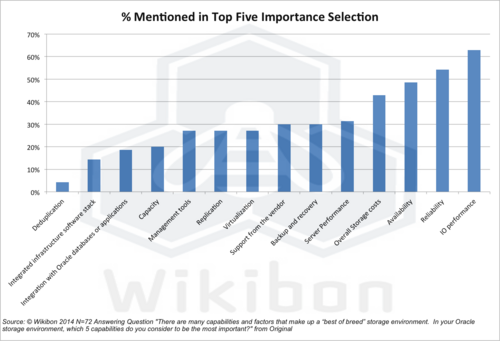
Source: © Wikibon Survey, 2014
N=66, Q: There are many capabilities and factors that make up a “best of breed” storage environment. In your Oracle storage environment, which 5 capabilities do you consider to be the most important?
Same as Figure 1
However, when the single most important factor is analyzed, availability and reliability take the first two spots. It is clear that reliability is the most important factor, followed by IO performance a distant second.
Figure 9 below shows one of the most striking findings of the survey. In the paragraph above we emphasized the importance of storage infrastructure in Oracle environments. We also asked “In your estimation, which vendor has the best storage offerings in Oracle environments?” EMC was rated "best" by 42% with Oracle coming in second (16%). The remaining seven vendors averaged ~6% (Hitachi & HP had 11%, and the rest 5% or less). The designation of "best" for EMC and Oracle is much higher than their respective designation of currently "most important" Oracle storage environment vendor (29% for EMC and 10% for Oracle).
Conclusions
The full survey results in conjunction with other Wikibon research leads us to conclude that overall reliability for Oracle systems is function of:
- Availability of all infrastructure components:
- Redundancy of servers,
- Redundancy of IO paths to server and storage,
- Recoverability (ability to meet aggressive RPO/RTO SLAs),
- Improved RTO with high-performance snapshots & backup appliances,
- Virtualized resources for speed-of-recovery,
- Consistent storage performance (with low time to storage innocence),
- Consistent and adjustable storage performance (e.g., tiering with flash),
- Integrated tools with the ability to present to both storage admins and DBAs,
- Ability to use server-flash & all-flash arrays when necessary.
The conclusion of the study is that in most data centers where Oracle is the key or a key workload, the value of best-of-breed open infrastructure has both business value and IT advantages over other infrastructure offerings. Some sites with extremely high availability requirements and high integration between Oracle database and business software may find the all-Oracle application-aware software approach to be preferable, given their specific business requirements. However, Wikibon believes that the “fat middle” of the “Oracle-intense” market (Figure 2 above) should obtain maximum value from a best-of-breed open infrastructure approach.
Wikibon found that EMC has the richest and most highly regarded set of Oracle infrastructure functionality compared with other vendors. The Wikibon survey also found that EMC has by far the greatest storage mindshare, with 42% of the participants selecting EMC as having the best storage offerings in Oracle environments. Oracle has 16% of mindshare, and is ahead of the other storage vendors. EMC also headed the converged infrastructure vendors with VCE block heading the table with 16% of respondents selecting it as the most important server, and Oracle has 10%.
Action Item: Infrastructure executives with responsibility for Oracle infrastructure environments should always look carefully at vendors whose mindshare is significantly greater than their marketshare! Wikibon would recommend that EMC be included for all RFPs for Oracle infrastructure environments. For very Oracle-intensive environments where Oracle software is being used for very high availability, both EMC & Oracle should be included in the RFP
Footnotes:



